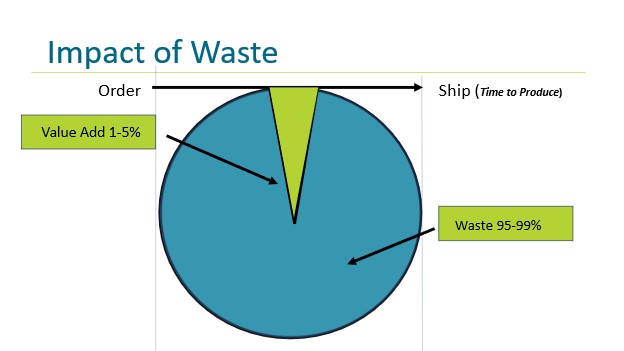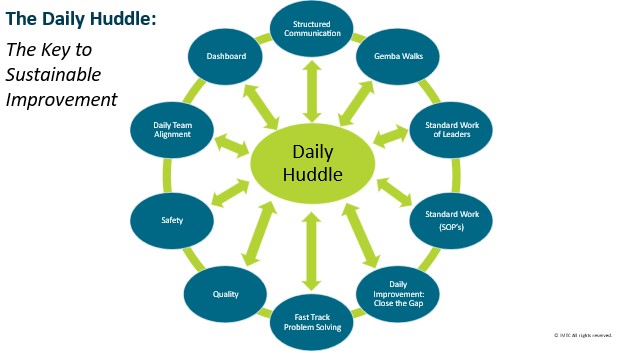
“THE MOST IMPORTANT OF ALL MEETINGS IS NOT THE ‘BIG MEETINGS’, BUT THE SHORT AND POWERFUL DAILY HUDDLE” (Growth Institute Blog)
Working with numerous small to medium sized, mostly family-owned manufacturing companies, I have found there is an ongoing struggle in their lean transformation away from a traditional approach to manufacturing. Why is that?
First, let us take a step back and look at some of the key principles of lean manufacturing:
- Value is ultimately determined by the customer…What are they willing to pay (or not pay) for an item or service?: This is usually reflected in the price.
- Value is created on the shop floor: When you think about it, most value is created when direct labor and materials are brought together (many times with the assistance of machines) to create an item or service the customer is willing to pay for. This is not to suggest that support services, including - but not limited to - Senior Leadership, Finance & Accounting, Sales, Marketing, HR, etc., are not important. Certainly, they are important, and without them the creation of value cannot take place, but the customer does not want to pay for them.
- The cost of creating value and knowing what the customer is willing to pay in its simplest form determines profit: Profits are used to invest further in the business, whether it’s growing sales/market share, introducing new technologies, rewarding the team, etc.
- The cost of creating value is primarily impacted by the amount of waste encountered while creating value: Toyota has identified them as the 8 deadly wastes: Transportation, Inventory, Motion, Waiting, Overproduction, Over Processing, Defects, and Underutilization of Human Talent. In fact, studies have shown the time from taking an order to the time in which it gets paid, 95-99% of that time is consumed in non-valued activities or waste; actual value-added time consumes only 1-5% of the time.

Back to the initial question, based on the discussion above: most small companies do not have a structure in place on the shop floor to drive daily execution and drive out waste, with a focus on continuous improvement, aligned with company goals and objectives. They are stuck in the traditional top-down mode of management vs. a lean leadership/collaborative approach. The Daily Huddle provides the critical structure and opportunity for employee engagement to accomplish the above.
The Daily Huddle is a pillar of the lean management system as described by David Mann. There is a direct linkage from Strategic Planning to execution on the shop floor. Execution is what the team is going to do today - not next week, not next month.
Consider the visual below. The Daily Huddle should be the center of information flow into and out of the shop floor. Why is this critical? The shop floor is where value is created. It is on the shop floor where execution is imperative. It is on the shop floor that most improvements are made and sustained. The Daily Huddle provides the structure and information flow.

Gemba Walks provide critical information for the shop floor to address problems or opportunities. Daily team alignment informs the team what needs to be accomplished today to meet customer orders. Feedback from SOP audits provides validation that Standard Operation Procedures are being respected or have the opportunity to be improved through the PDCA process. Feedback from Safety and Quality systems will provide critical information to the shop floor team. Updated dashboards informs the team how they're doing and what improvements need to be made. Finally, the Daily Huddle provides the ideal environment for team engagement and participation.
The Daily Huddle is the command and control center for information coming in and out of the shop floor, leading to operational excellence focused on Safety, Quality, On Time to Produce, Cost, and Continuous Improvement. The Huddle provides objectives for the day, awareness of what is getting in the way of the work, problems that need to be solved, and sustainable continuous improvement.
So where do we start - what is the road map for a robust Daily Huddle process?
- Determine the team members participating in the Huddle.
- Determine when and where the Daily Huddle will take place.
- Develop a SOP Agenda and keep the Daily Huddle to 15 minutes or less. (As noted, at minimum the daily huddle will cover Safety, Quality, On time to Produce/Deliver, and Cost).
- Create an information board with shop floor level KPIs and other valuable information.
My challenge to you is to start your daily huddles. As with any new processes, we learn by practicing. Do not get discouraged, the process will improve. Over time, you will customize the process to meet the uniqueness of your shop floor, and you will see improvement in daily execution.
IMEC is here to support your team, feel free to contact your Regional Manager - they are here to help.

.jpg?width=100&height=100&name=IMG_1505%20(2).jpg)


